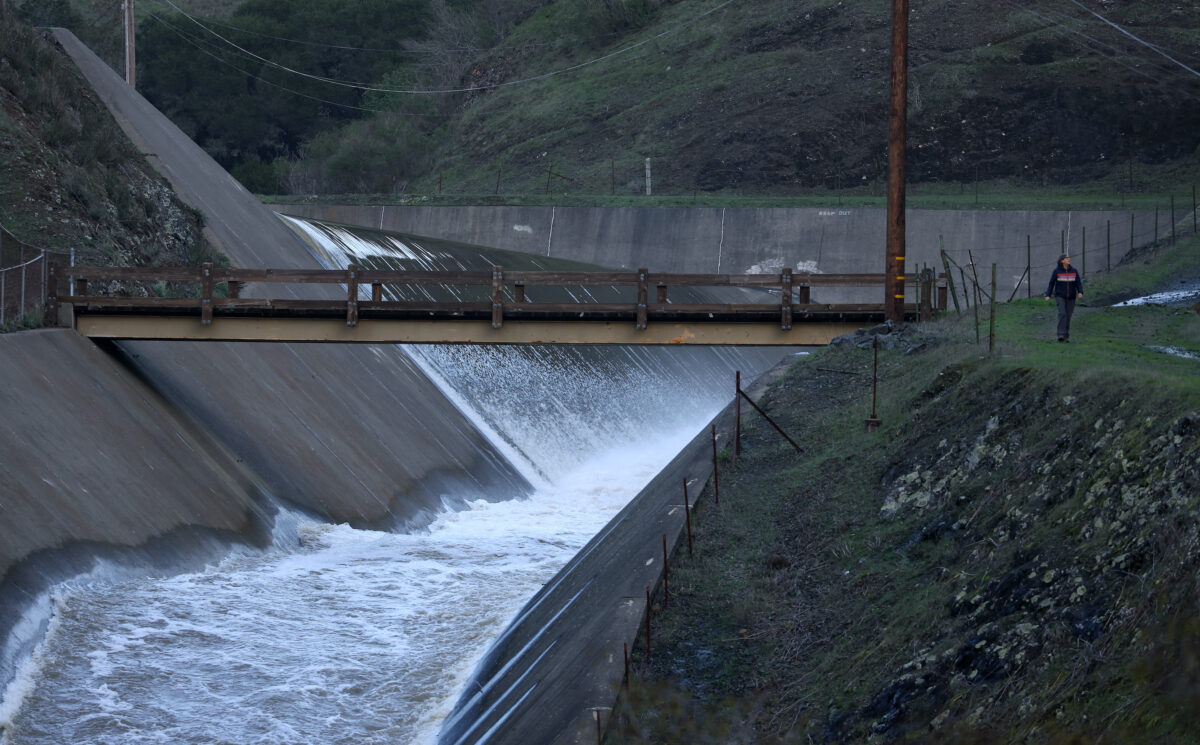Newsom Under Fire From Bipartisan Critics Over Trillions of Gallons of Lost Water
By Epoch Times Staff
California flushed trillions of gallons of rainwater from January storms out to the ocean instead of saving it in reservoirs and pumping it to farmers after three years of extreme drought.

California flushed trillions of gallons of rainwater from January storms out to the ocean instead of saving it in reservoirs and pumping it to farmers after three years of extreme drought.
Since late December, a series of heavy storms called atmospheric rivers brought an estimated 32 trillion gallons of rainwater to the state, according to the FOX Forecast Center. U.S. Geological Survey data suggest this would be enough to supply the state’s agricultural, industrial, and residential needs for at least a decade—if it were stored in reservoirs.
However, around 95 percent of the rainwater in the Sacramento-San Joaquin River Delta, the hub of California’s water grid, was washed out to sea, according to the U.S. Bureau of Reclamation.
The bureau told The Epoch Times in an email on Jan. 23 that 5 to 6 percent of incoming water during the storms was captured.
Nearly a dozen legislators—both Republican and Democrat, several from the parched agricultural regions of the Central Valley—recently sent a series of letters demanding that California Gov. Gavin Newsom ease pumping restrictions on water from the heavy rains. The environmental restrictions are designed to protect endangered fish such as the Delta smelt.
Missed Opportunity?
U.S. Rep. Jim Costa (D-Fresno) wrote a letter (pdf) to Newsom, California Natural Resources Secretary Wade Crowfoot, and U.S. Interior Secretary Deb Haaland on Jan. 11 calling on federal and state agencies to maximize pumping water from the rains, contending this would have little impact on endangered species.
“Community drinking water systems, agriculture, and listed species that occupy managed wetlands alike would benefit from an increased supply of stored water for use during the next dry period,” Costa wrote. “If the 2022 water year is any indication, that could come as soon as next month. It makes NO sense to miss the opportunity created by the extraordinary wet conditions California is now experiencing.”
Costa suggested the state discontinue its “calendar-based approach” to water management and implement more adaptive “dynamic” strategies to respond more quickly to changing weather patterns and conditions.
“Water needs to flow freely to the Central Valley,” Assemblyman Vince Fong (R-Bakersfield) wrote in another letter to Newsom on Jan. 12. “During this drought, farmers need water to save for the coming dry months in order to grow the food we eat, and communities need water for homes and businesses.”
State legislators Sen. Melissa Hurtado (D-Sanger) and Assemblywoman Jasmeet Bains (D-Bakersfield)—citing data from the Bureau of Reclamation—stated in yet another letter to Newsom on Jan. 10 that water usage from the Delta between Dec. 31 and Jan. 8 was cut by more than half from about 6,000 cubic feet per second to a daily average of less than 3,000.
The lawmakers also objected to California Department of Water Resources (DWR) Director Karla Nemeth’s assertion the previous week that “dialing back the pumps” would protect “imperiled fish.”
“After several years of drought and low reservoir levels, it only makes sense to capitalize on wet conditions by maximizing south of the Delta exports at a time when the water is available,” Hurtado and Bains wrote.
Nemeth responded to Hurtado and Bains in a letter obtained by The Epoch Times on Jan. 11 stating the State Water Project increased the movement of water into storage at San Luis Reservoir since the storms began Dec. 27, and that “the export of water from the south Delta is continuing at a rate that is significantly higher than it was before these storms.”
Prior to the heavy rainfall, pumping in the Delta had been approximately 300 cubic feet per second, but starting in late December it was increased to an average of 3,000, Nemeth said.
The DWR had projected pumping to progressively increase to more than 6,000 cubic feet per second over the next two weeks, Nemeth said at the time of writing the letter.
“The ‘dialing back’ you quoted in your letter was my reference to existing law that requires turbid water generated by high flows in the central Delta to first move through the system. This so-called ‘first flush’ pumping protocol is required by federal and state permits,” Nemeth wrote.
DWR was not authorized to end the “first flush” protocol until Jan. 16, she wrote in the letter.
The U.S Bureau of Reclamation stated that the agency “pumped the maximum amount of water allowed at the federal Jones Pumping Plant,” in an email to The Epoch Times.
Water Infrastructure
State Assembly Republicans held a press conference in Sacramento on Jan. 12 calling for major improvements to water infrastructure and urging Newsom to prioritize flood protection, water storage, and conveyance projects.
Republicans said the governor’s proposed state budget “fails to invest in critical infrastructure” to protect residents from floods and capture water for future use.
Assemblyman James Gallagher (R-Yuba City) said there is a shortage of water for drinking and irrigating crops in the Central Valley. He urged Newsom to build new reservoirs and streamline the process of getting projects approved by environmental agencies.
Assemblywoman Laurie Davies (R-Laguna Niguel) also urged Newsom to build new water reservoirs instead of telling Californians to conserve water.
“It’s time that we actually make a move,” she said. “This should have been done years ago.”
In 2014, the state issued a water bond under Proposition 1, which provided $7.5 billion, including $2.7 billion preauthorized specifically for water storage projects, according to the Public Policy Institute of California (PPIC).
So far, however, no new reservoirs have been built. Most of California’s dams and reservoirs were built between 1945 and 1968, with the last one—New Melones Dam and Reservoir—in 1979. New Melones is located about 100 miles southeast of Sacramento.
Newsom has pushed for completion of the Sites Reservoir, a long-delayed proposed project on the west side of the Sacramento Valley, but environmental groups have strongly opposed it, and construction is unlikely to begin before 2024.
In a statement emailed to The Epoch Times on Jan. 23, Sen. Shannon Grove (R-Bakersfield) criticized those blocking new water storage projects and the repair of existing infrastructure in the state, citing the important role of agriculture in the Central Valley as a major concern.
“For those farmers to continue growing a quarter of the nation’s food, California needs to store its water in wet years and stop flushing it out to the ocean. Food is a necessity,” she said.
California’s nearly 1,500 surface reservoirs can store up to 43 million acre-feet of water, more than 1.4 trillion gallons, enough to supply farms and cities for a year, reported the PPIC.
One acre-foot of water is just north of 325,000 gallons, which according to the Environmental Protection Agency (EPA) is more than enough to supply two households with an average family of four for a year at a rate of 400 gallons per day per household, or 146,000 gallons for each.
The state’s 517 underground aquifers can hold considerably more water than surface reservoirs “because decades of groundwater depletion have created unused space,” according to the PPIC.
The underground aquifers were unregulated until 2014 when Gov. Jerry Brown signed the Sustainable Groundwater Management Act into law to recharge depleted groundwater, according to the DWR.
Environmental Delays
State Assemblyman Bill Essayli (R-Corona) called on Newsom to reform the California Environmental Quality Act and streamline the approval process of new water reservoir projects.
“The fundamental problem is that there’s no appetite or will to actually solve this issue and deal with the environmental groups that are relentless in their opposition to any water storage infrastructure. That’s the real problem,” he said.
He suggested the state look more toward desalination plants as a way to provide water to California’s coastal cities, similar to desert regions in other parts of the world, such as Dubai.
Dallas Weaver, a water expert and consultant based in Huntington Beach, agreed. Weaver told The Epoch Times that even though the state was a leader in developing reverse osmosis filters for desalination technology, it now lags behind the rest of the world when it comes to building its own desalination plants.
A spokesperson from the governor’s office told The Epoch Times in an emailed statement on Jan. 23 that under Newsom, “the state is moving aggressively to modernize water infrastructure to maximize stormwater capture and storage above and below ground.”
The state’s Water Supply Strategy (pdf) provides a roadmap for California to create an additional 4 million acre-feet of water storage capacity, boost annual groundwater recharge by 500,000 acre-feet, and expand urban stormwater capture capacity by 250,000 acre-feet by 2030, he said.
The governor’s proposed state budget includes $4.7 million to help agencies fast-track permitting for projects including groundwater recharge.
“Trillions of gallons of water from the recent storms are currently recharging groundwater basins throughout the state and the state’s two largest reservoirs have gained a combined [1.62 million] acre-feet of water,” or roughly enough to supply water to 5.6 million households for a year, the spokesperson said.
While recent storms have filled many of the state’s reservoirs to average or above average levels and improved water conditions, much of the state remains in drought following the past three years of severe drought—the state’s driest on record.
“Even as the state’s drought outlook improves, it’s critical that the water community all work together to advance drought planning and response for the state’s hotter, drier future,” said Nemeth, the DWR director.
The DWR recently launched an interagency task force “to proactively prepare for a return to dry conditions amid climate-driven extremes in weather,” the agency announced on Jan. 20.
“Initiated by Senate Bill 552, the DRIP Collaborative will foster partnerships between local governments, experts, community representatives and state agencies to address drought planning, emergency response, and ongoing management,” DWR stated.
The first meeting is scheduled for April 6.

Brad Jones
Brad Jones is an award-winning journalist based in Southern California.


